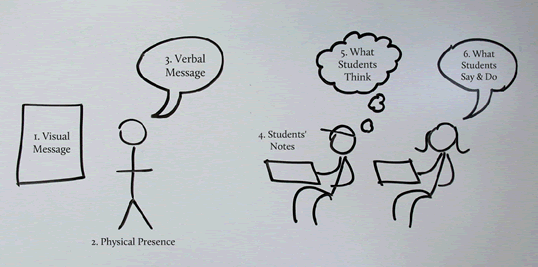Expanded CFT Teaching Guide on Lecturing – Basics, Visuals, Interaction
Leveraging resources collected for a spring 2010 workshop on engaging students in large lecture courses, the CFT has expanded its teaching guide on lecturing to include advice on the “basics” of effective learning, suggestions for PowerPoint slides and other visual elements of lectures, and strategies for fostering student engagement and interaction during lectures.
Here’s an except:
When planning a lecture, keep in mind that you have control or influence over several elements of your classroom:

- Visual Message – The slides and other visual aids you use can either complement or confuse your verbal message, depending on how you design them. Consider how photos and other images might function as metaphors that make your points more memorable. (For an example, see the “Lecturing Basics” slideshow above.)
- Physical Presence – While some instructors are naturally gifted public speakers, we can all be more aware of and leverage our physical presence to better communicate to our audiences. (Watch “The Act of Teaching: Theater Techniques for Classrooms and Presentations” for great advice from Harvard University’s Nancy Houfek on improving your physical presence in the classroom.)
- Verbal Message – Whether you prepare typed lecture notes or just improvise in the classroom, the words you say are an integral part of your lecture.
- Students’ Notes – Students can often spend more mental energy taking notes during class than thinking about your content. Consider ways you can make it easier for your students to take notes so they can focus more on engaging with your material.
- What Students Think – As Angelo and Cross say in their classic book Classroom Assessment Techniques, “teaching without learning is just talking.” How can you help your students mentally grapple with your material during class?
- What Students Say & Do – Keep in mind that even in a so-called lecture class, you don’t have to lecture the whole time. Consider small-group and whole-class activities that might enhance your students learning.

Leave a Response